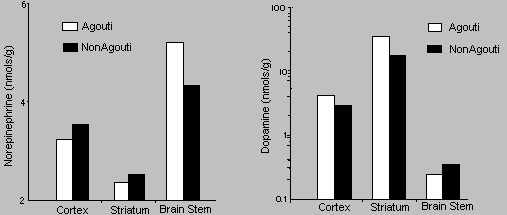The usual assumption of genetic engineering is that altering a single gene will result in the alteration of a single characteristic. Unfortunately, genes often have more than one function. When they do, genetic alterations will have unexpected side effects. Understanding these pleiotropic effects then is crucial to understanding the kinds of responses we should expect when we genetically engineer organisms to our specifications. My research investigates the multiple effects a gene can have in the deer mouse (Peromyscus maniculatus). This common and wide spread mammal is a frequent denizen of our deciduous forests. Like other mammals the color of its fur is under genetic control.
Many different genes regulate coat color in mammals but five of them are well studied. One of these is the agouti gene. Because major coat-coat genes (such as agouti and albino) function in most mammals, they are excellent model systems for investigating genetic effects and extrapolating the results to other mammals such as humans.
Differences in the color of the fur are the obvious effect of the agouti gene but we have found numerous other differences as well. Some are also related to the animal's coat such as the density of the fur and the length of individual hairs. Others appear to have no connection to the pelage at all. Included in these are differences in the responses of animals to stress and to photoperiod. These results suggest more general effects of the agouti gene on physiological function not just coat color. Our preliminary work also suggests anatomical differences in testis weight and spleen size.
Along with anatomical and physiological differences we have observed differences in important signalling chemicals in the brain and the anatomy of the brain itself. Given these differences, we were not surprised to also find differences in the behaviors of the animals, and we did. We see differences in general activity levels, in aggressive responses, in responses to handling, and in grooming behavior. Very similar behavioral differences are also observed in rats which differ at this genetic locus. Thus we have confidence that our results are generally applicable to mammals not just to deer mice.
Thus a single gene appears to influence the animal on several levels: molecular, anatomical, physiological, and behavioral. Research in other labs suggests that the product of the agouti gene is a protein which interferes with a wide-spread and multifunctioned family of hormones: the melanocortins. These blood-born hormones regulate numerous physiological responses via a family of receptors on the surface of cells. Agouti may accelerate or retard the effect of these potent hormones by attaching to these receptors and thus altering the way in which the hormone triggers the cell to function.
Clearly, the genome of any species is not a simple series of linear one-step instructions, but a complex and interconnected network of anastomosing algorithms which simultaneously drive multiple and overlapping biochemical and physiological processes. Understanding the epistatic effects of the agouti coat-color locus will provide a small window to this elusive yet pervasive phenomenon.

Figure 1. Norepinephrine and dopamine levels in the brains of two colormophs of deer mice.

